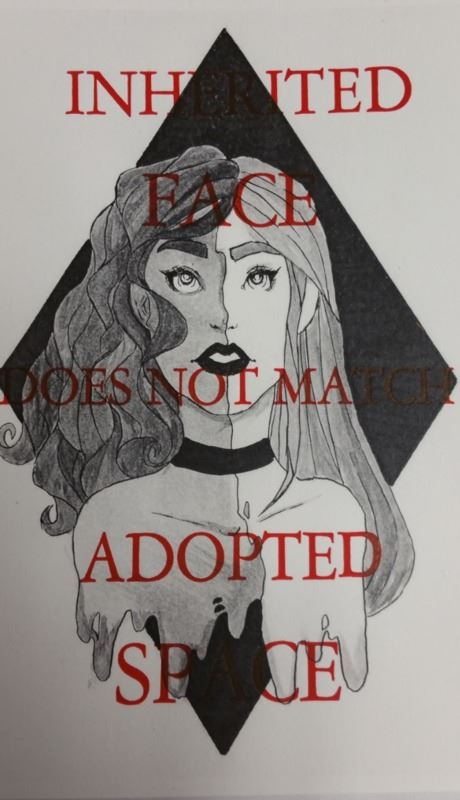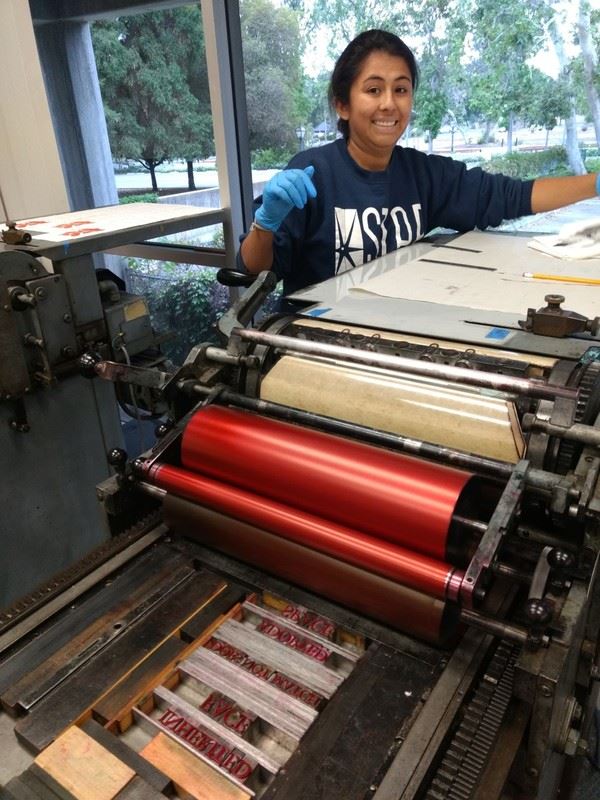
Student: Catherine (Kiki) Glah
1. Did any of the artists' books inspire you to create?
I’ve always felt that the strongest artistic processes begin as a response to others work. Our art gains meaning through the context of it’s creation, and can act as a dialogue between varying ideologies, cultures, and identities. So as an artist who tries to make works discussing issues such as race and gender oppression through a contemporary lense,
I was heavily inspired by the Of Color: Race and Identity exhibition.
Visually the work that inspired me the most was Alison Saar’s Mami (or how to know a goddess when you see one), with her bold, distinct styles and often monotone color schemes. There was something inherently powerful in the way that her simplified figures were displayed; it was as though their simplicity allowed me to connect with them in a very instinctual, almost primal, way. I would love to explore if I can evoke similar emotions in my own work, though through a different style of course.
2. Which piece did you have the strongest reaction to? Why?
I had the strongest reaction to Tona Wilson’s Stories Behind Bars. The artist book was laid out in such a way that it really forced the viewer to humanize the people behind prison bars; especially with the cover of the bars being juxtaposed with the interior book covers displaying portraits of the prisoners. So often we ignore these powerful stories because we tell ourselves that the imprisoned people deserve it, and allow ourselves to be content with that mentality. This work was a reminder to me that by dehumanizing and disregarding the stories of these people, you buy into a deeply flawed system that perpetuates discipline and racism instead of justice. Everything in the work was so personal, from the handwriting to the way that the images were framed to conveying the confusion and tension that the prisoners might have felt while serving out their respective times.
3. Did seeing any of the work trigger thoughts/memories of experiences/events that have impacted you? Please explain.
Mix and Match Families by Jaime Lynn Shafer was a book that caught me off-guard in some of the best ways. I am adopted, and as a result, have struggled to feel as though I truly fit in with my family all my life. Growing up I was constantly asked if I was a “friend of the family” or if I was from another marriage. One particular neighbor even asked my mother if I was the result of an affair, and told her that she should be thankful that my father stayed with her. Looking at a piece of work that addresses how complex modern American families are almost overwhelmed me. This was especially true when I considered how much a piece like that could have helped my come to terms with my relationship to my family when I was younger. It was reassuring to see how many variations of people could come to call themselves a family, and it definitely helped me feel less alone in my personal struggles.
4. How has the class broadened or challenged your perspective of race and identity?
So often I look at race and identity through my own lense, and I’ve always found that it centers on a few specific topics. For a long time I’ve considered identity to be something that is worn like a badge; it is a composite of category on category. I figured our identity, in many cases, is not a result of our choices or opinions, rather it is simply what a person is or isn’t. For example, I felt that my identity was defined by what race, sexuality, age, and gender I was; all things I have no control over. But through observing how others define race and identity, I’ve come to realize that they aren’t just labels or composites. Our identities aren’t just what we are categorized as, they are how we chose to react and use those labels in our lives. Of course others will interpret our identities in their own way and we are incapable of controlling how they do so, but we chose what we feel are the most important aspects of our character. There is agency in identity.
5. What is your take away from the class? What will you remember 10 years from now?
My takeaway from the class is simple; the struggle for defining identity is universal. We are all impacted by things like race and sexuality and gender, and we are never the first to struggle with these issues. There is something incredibly empowering about being able to band together with those who are challenged by similar problems, and it becomes easier to address them in a group. If we listen to how others have learned from their experiences we can expand our own identities. Ten years from now I’m not sure what I will remember. I wish I could say that I’d remember the exact artists, or how if felt to look at their work and reflect on my own definitions of race and identity. If possible, I would like to remember that none of us are truly alone in our journey to discover who we are. And I hope I remember the importance of documenting that journey to help others grow and learn in their own right.

Catherine (Kiki) Glah, “Adopted,”
Of Color: Race & Identity in Artists' Books





